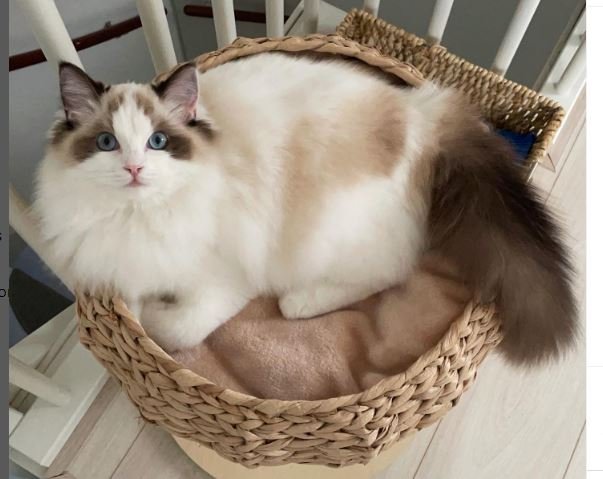Identifying a Ragdoll cat involves looking for their trademark blue eyes, large size, fluffy tail, and unique colors and coat patterns that make them stand out. Pay attention to their Siamese-like markings, pointed style coat, and mitted patterns with white paws. Their gentle nature, affinity for going limp when held, and love for lounging on laps are all telltale signs.
Ragdolls are known for their specific coat patterns like colorpoint, mitted, or bicolor, along with their affectionate demeanor. These traits, along with their striking blue eyes and white fur accents, are the hallmark features you can spot in a Ragdoll cat.
Step 1: Look at the Coat
The first thing you’ll notice about a Ragdoll is its soft and silky fur. Unlike some long-haired cats, Ragdolls have a semi-long coat that feels incredibly soft to the touch, almost like silk. Their fur is not as thick or heavy as other long-haired breeds, but it’s still fluffy and plush, making them look huggable.
Ragdolls come in three primary coat patterns:
- Colorpoint: This is the most typical pattern where the cat’s ears, face, paws, and tail are darker than the rest of the body. The body itself is lighter in color, creating a striking contrast.
- Mitted: These Ragdolls have white paws and a white “bib” (chest) while the rest of the coat is dark on the face, ears, paws, and tail.
- Bicolor: Bicolor Ragdolls have a lot more white in their coats. Their face usually has a white “V” shape, and they tend to have white paws and a white stomach, with dark points on the face, ears, and tail.

Step 2: Check the Size
Ragdolls are large cats, often considered one of the largest domestic cat breeds. They can weigh anywhere from 10 to 20 pounds, with males being larger than females. Their large size, combined with their muscular, sturdy bodies, gives them a very regal and imposing appearance. Ragdolls have a rectangular body shape, which adds to their elegance.
- Males: Typically weigh between 15-20 pounds.
- Females: Weigh between 10-15 pounds.
If you’re looking at a cat that is larger than average, has a solid build, and a long body, it could very well be a Ragdoll.

Step 3: Observe the Eyes
One of the most defining features of the Ragdoll cat is their striking blue eyes. Ragdolls are known for having large, oval-shaped eyes that are a brilliant, vibrant shade of blue. These eyes are a hallmark of the breed, and unlike some other cat breeds, Ragdoll’s eye color doesn’t change as they age.
- Ragdoll Eye Color: Deep blue and bright.
If the cat you’re observing has beautiful, large, and bright blue eyes, it’s a strong indication that it might be a Ragdoll.
Step 4: Look at the Body Shape
Ragdolls have a long, rectangular body shape that is unmistakable. Unlike cats with a compact or rounded body, Ragdolls have an elongated frame with a broad chest and sturdy bone structure. Their long body gives them a graceful, elegant appearance, which is further accentuated by their thick fur. This sleek yet muscular body is part of what makes Ragdolls so beautiful and distinct.
Their long bodies contribute to their “floppiness” when you pick them up. Ragdolls are famous for going completely limp, like a ragdoll (hence the name), which adds to their unique, relaxed personality.
Step 5: Pay Attention to Their Personality
Ragdoll cats are not only known for their physical characteristics but also for their incredibly sweet and affectionate personalities. They are often described as “dog-like” in their behavior because they tend to follow their owners around the house and love being around people. Unlike many other cats, Ragdolls are calm, friendly, and docile, which makes them ideal companions.
Ragdolls are often more than happy to be held and cuddled, and many will even greet you at the door when you come home. They enjoy spending time with their family members and often seek attention and affection. If the cat you’re observing is extremely sociable, enjoys being handled, and follows you around the house, it could be a Ragdoll.

6. Tail: Long, Fluffy, and Proportionate
A Ragdoll’s tail is long, fluffy, and perfectly proportionate to its body. It’s often described as plumed, with soft, thick fur that adds to its elegant look. The tail is not overly stiff or thin like some other breeds but instead flows naturally behind them, adding a sense of grace as they move.
7. Ask a Professional: Get a Pedigree Certificate
If you’re still unsure whether a cat is a Ragdoll, the best thing to do is to consult a breeder or veterinarian. A purebred Ragdoll will typically come with a pedigree certificate, proving its lineage and confirming its breed. Reputable breeders often have Ragdolls that are registered with organizations like the CFA (Cat Fanciers’ Association), TICA (The International Cat Association), and Ragdoll Fanciers Worldwide.
If you’re looking to adopt or buy a Ragdoll, it’s always best to go through a breeder who is knowledgeable about the breed and can confirm the cat’s purebred status.
Step 8: Examine the Ears
Ragdolls have medium-sized ears that are broad at the base, slightly outward-facing and have rounded tips. The ears are not pointed
If you encounter a cat with ears that are neither too small nor too large, and they have a slightly rounded tip, it’s a good sign that the cat could be a Ragdoll.
I Share images of all types of Ragdoll cats you see and easy to identify The Ragdoll





Hey guys, My name is Simon Smith. I’m from Canada and live near Victoria
I live with my sweet family and have 20+ Ragdolls of different types. I love them as my children. My profession is as a hotel manager.
I love to keep Ragdolls and grow their breeder case. I have 7 years of experience.
I’m an expert in cat care. So, I’m here to provide you with new information about my cats daily. This is my blog website, so I request that you kindly visit our site daily.
If you’re a Ragdolls lover and you have any questions or confusion about cats, text me on the Contact Us page or Gmail.
Thank u
